A guide to some of the most beautiful and fascinating fountains that you can find in Rome.
Water was a sacred gift from the gods for ancient Romans. The word fountain, “fontana” in Italian, is rooted in the name of the guardian of wells and springs, the beloved god Fons. Rome is the only city in the world that houses two thousand fountains for quenching the public's thirst.
A sip of fresh water is always freely available. These days Rome’s fountains make headlines due to misbehaving foreigners diving naked or partially clothed into their cooling waters.
But they continue to add a sense of wonder and a touch of magic to Roman days and nights. Here are the top 10 to discover.
Fontana delle Naiadi
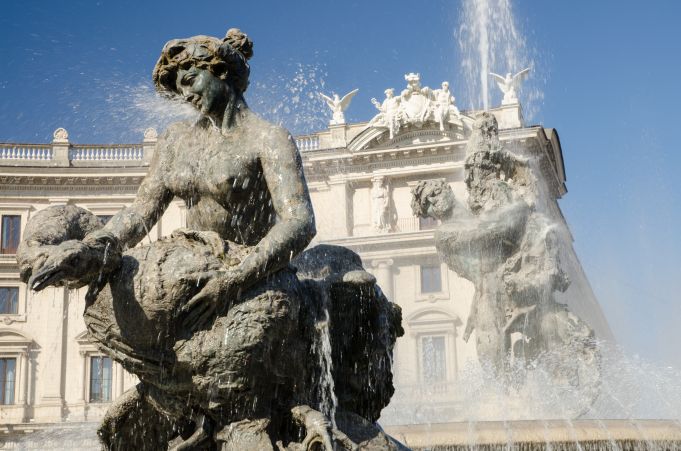
Editorial credit: Marco Mariani / Shutterstock.com
We suggest you start your exploration of Rome's fountains from around Termini station. A few steps from the station is Piazza della Repubblica with its imposing Fountain of the Naiads.
What is certainly most beautiful about it is the decoration composed of four female figures depicting the naiads: the Nymph of the Lakes, with a swan, the Nymph of the Rivers, lying on a water monster, the Nymph of the Underground Waters, lying on a dragon, and the Nymph of the Oceans riding a horse.
Upon its inauguration, at the beginning of 1900, the sensual position of the statues and the brightness of the wet bodies was deemed an immoral spectacle for the most fervent Catholics, and the fountain was surrounded by a fence to prevent its view, awaiting the verdict of the City Council that, ultimately, decided not to remove the statues.
The sculptures in the center were originally quite bizarre: three tritons, a dolphin and a large octopus, clinging to each other apparently in a fight. In fact, people at the time renamed them "the mixed fried food of Termini" and they were removed (though you can still see them in Piazza Vittorio).The sculptor replaced it with the Greek god of the sea Glaucus grasping a dolphin, a symbol of the dominion of man over nature.
Nevertheless, it didn’t escape the Romans’ sense of ironic humor. The new statue was said to be "of the man with the fish in his hand, who wets the ass of women".You might have to see it to understand the joke…
Fontana del Tritone
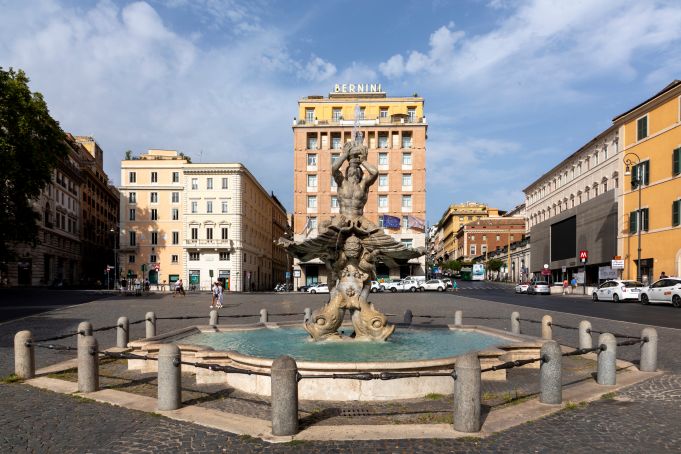
Editorial credit: travelview / Shutterstock.comJust one metro stop away, in Piazza Barberini, there is another beautiful fountain that bears the signature of Gian Lorenzo Bernini. We’re talking about the Triton Fountain.
The fountain dates back to 1642 and became the favorite haunt of many artists. Made entirely of travertine marble, the central sculpture features four open-mouthed dolphins intertwining their tails above which they hold a large shell, in the center of which stands the god Triton. Between the tails of the dolphins can be seen the two papal coats of arms with the three bees, symbol of the Barberini family, commissioner of the work.
Fontana della Barcaccia
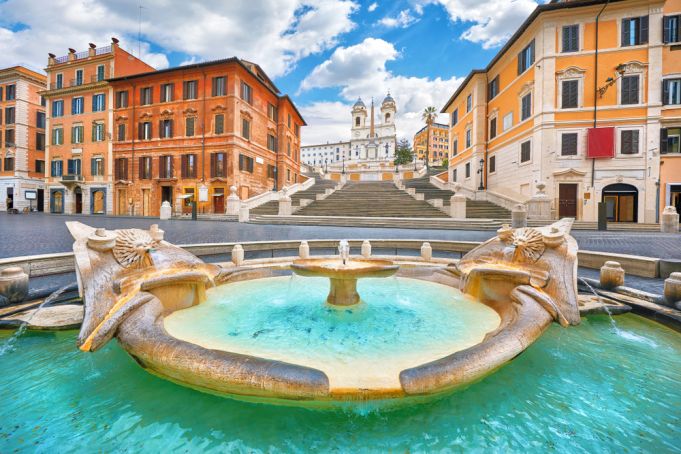
Taking the road called Via Sistina you will arrive at Trinità dei Monti, where, at the foot of the Spanish steps you can admire the fountain of Pietro Bernini, the Barcaccia.
Its construction was fraught with difficulty because at that time the aqueduct had such low pressure that it did not allow the formation of gushes. The sculptor, however, solved the problem by designing the fountain in the shape of a boat in a basin slightly below street level.
In the middle of the boat there is another small basin from which a gush of water comes out, which, once the basin is filled, falls inside the boat and overflows into the basin below.
Legend has it that the idea of the boat came to Bernini from the presence of a boat shipwrecked in the square by the flood of the Tiber in 1598.
Fontana di Trevi
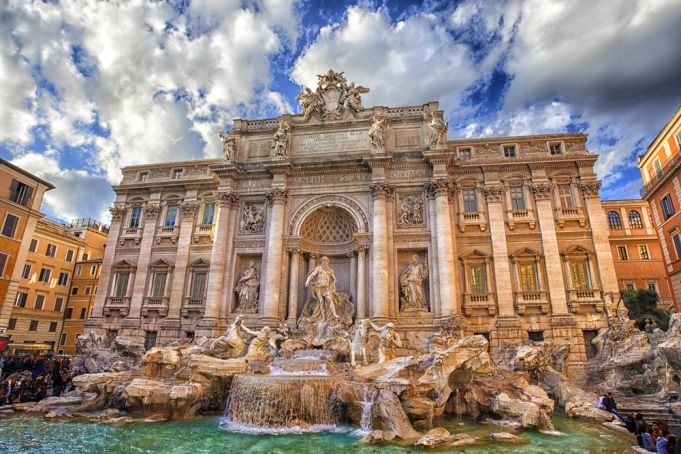
Following the crowds down the winding road of Via della Stamperia, you’ll reach the mandatory stop on this tour: the Trevi Fountain. One of the most spectacular works of art in the city, we’ve fallen in love with it and often daydream of spending a night in the only hotel that allows a view of the fountain from its rooms. The sea -themed fountain is set in a large rectangular pool with rounded corners below street level.
Tradition states that by throwing a coin backwards with your eyes closed, into the water of the fountain, your return to the city is assured. All of the coins recovered are donated to charity.
Just don’t do an Anita Ekberg and wade into the waters – you’re more likely to end up with a heavy fine than an Oscar.Tip for lovers: The Fontanella degli Innamorati is located to the right of the Trevi Fountain, a small fountain but with an ancient tradition. Despite being very simple, its romantic symbolism refers to the eternal fidelity of couples who drink the water together.
Fontana del Pantheon
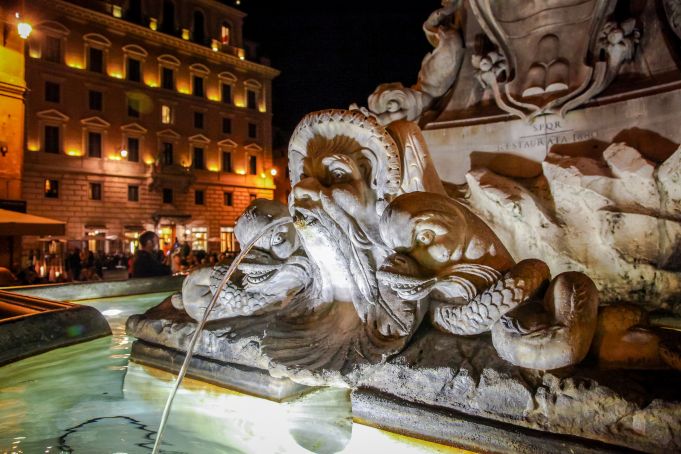
Editorial credit: Ilia Baksheev / Shutterstock.com
Grab a regenerating cone of gelato and continue down the cobblestone streets to the Pantheon.In the center of the square there is a Renaissance fountain designed around 1575 by Giacomo Della Porta and fabricated by sculptor Leonardo Sormani.
Today, only the basin remains of the original fountain. The masks have been replaced with copies and the grates that once protected the fountain have been removed.
The most evident modification to the fountain in Piazza della Rotonda is the substitution of the upper basin with an obelisk supported by a fake cliff.
This is one of the thirteen ancient obelisks of Rome, known as the Macuteo Obelisk, made at the time of the famous Pharaoh Ramses II (r. 1279-1213 BC) and transported to Rome by the notoriously cruel emperor Domitian.
Fontana dei Quattro Fiumi
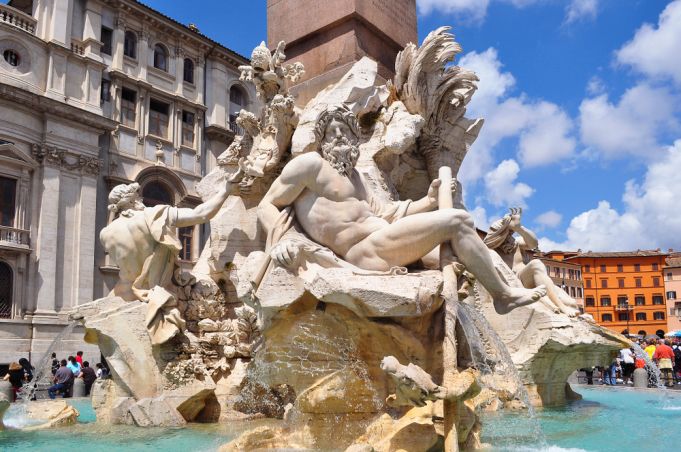
Another fountain not to be missed, and just a short walk from the Pantheon past the government buildings of the Italian Senate, is the very famous fountain in Piazza Navona by Bernini: the Fountain of the Four Rivers.
The fountain supports a copy of an Egyptian obelisk, from the Circus of Maxentius, which rests on a hollow base.Four gigantic figures personify the great rivers of four continents: the Nile, the Ganges, the Danube and the Rio de la Plata.
The Danube points to one of the two Pamphili coats of arms on the monument as if to represent the Pope's religious authority over the world, the Nile covers its face, a reference to its sources which were unknown at the time, the Rio de la Plata holds a sack overflowing with coins, symbolizing the silvery color of the waters, and the Ganges holds a long oar suggesting the navigability of the river.
Seven animals are depicted on the fountain: a dove, a horse, a crocodile near the Rio de la Plata, a lion, a dragon wrapping itself around the oar held by the Ganges, two snakes and a dolphin.There is also evidence that the fountain had been painted gold in some places, just so by its lustrous creator, to give it a touch of color and shine.
Le Fontane Gemelle (Piazza Farnese)
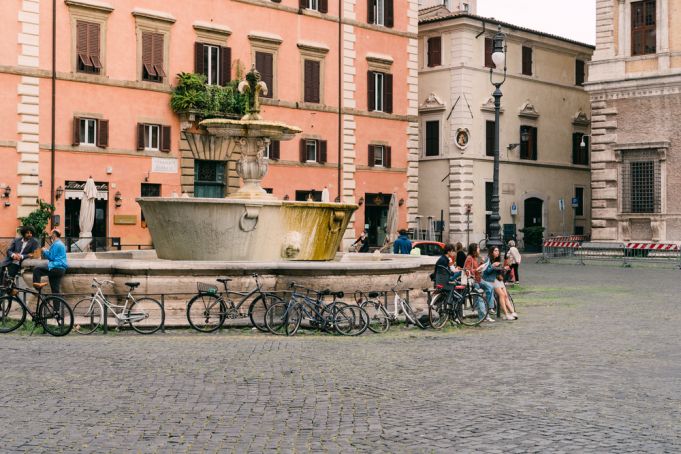
Continuing your journey through Rome led by the pursuit of its best fountains, wander straight through Campo di Fiori to Piazza Farnese. There are a pair of twin fountains in Piazza Farnese. In actual fact, they are two bathtubs made of Egyptian granite that were brought from the Baths of Caracalla and placed in front of the then newly erected Palazzo Venezia by Pope Paul II in 1466.
Later Pope Paul III of the Farnese family had them transported to the square in front of his palace in 1580. At that time, they had a purely ornamental function as they resided in a part of the city inaccessible to aqueducts.
However, in 1626 Girolamo Rainaldi adapted them into fountains fed by water from Acqua Paola.
The artist raised the two basins (decorated with lion reliefs), providing them with two internal spouts and placing Farnese lilies elegantly in the centers (originally in travertine, then rebuilt in marble during a restoration carried out in 1938), from which gushes of water rise and fall.
Tip for foodies: Stop for a “pizza ripiena” to go - plain focaccia bread stuffed with fresh prosciutto and mozzarella - at Il Forno. Eat it under the sun, leaning against the edge of one of the fountains in the square, admiring the Palazzo Farnese.
Fontana di Santa Maria in Trastevere
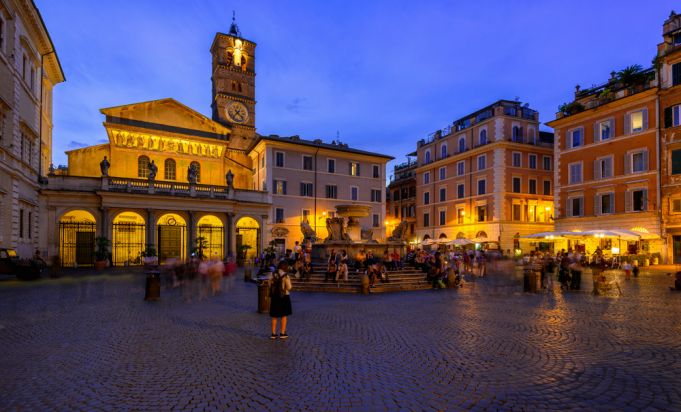
To get to the next fountain on our list, you must cross the bridge over the Tiber into the Trastevere neighborhood. Head past the clothing shops and bakeries toward the central square and stop in front of one of the oldest churches in Italy, the Basilica Santa Maria in Trastevere.
Often crowded with people perched on its steps, the fountain in Piazza S. Maria in Trastevere is considered the oldest monumental fountain in Rome, having undergone restorations by Girolamo Rainaldi, Gian Lorenzo Bernini and Carlo Fontana.
The last restoration dates back to 1930. Yet, despite various interventions over the centuries, the fountain has substantially preserved its original 15th century architecture.
Tip for photographers: Spend a little time in the square watching the light reflect across the golden details of the church's facade, and capture some typical scenes of Roman life happening here.
Fontana dell’ Acqua Paola (Il Fontanone)
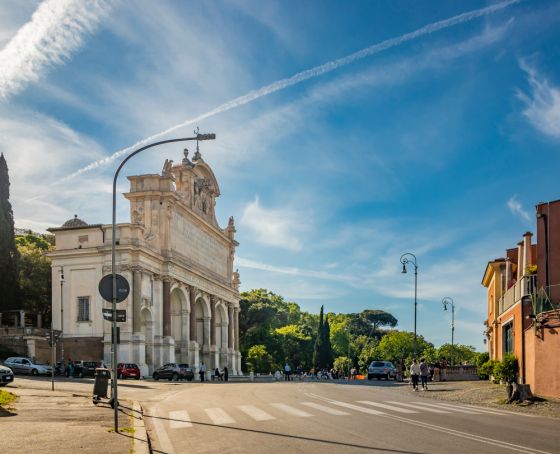
Up the hill that rises above Trastevere, you will find a very famous fountain. Classic Italian love ballads have been dedicated to it and Oscar- winning movies feature it. It is the Fontana dell'Acqua Paola, better known as Fontanone del Gianicolo, which overlooks a breathtaking panoramic terrace.
Situated near the beautiful hill and stunning Piazza of Gianicolo, it stands alone as if presiding over Rome. This seventeenth century fountain was built in 1612 to mark the end of the Acqua Paola aqueduct, restored by Pope Paul V, was the first major fountain on the right bank of the Tiber river.
To be honest, the climb is about 20 minutes to reach this gem of a fountain, but once you’re at the top you will thank us!
Tip for lovers: While you're on the Janiculum Hill, from the very romantic terrace of Piazzale Garibaldi, don't miss the cannon shot that marks the hour of noon for Romans.
Fontana delle Tartarughe
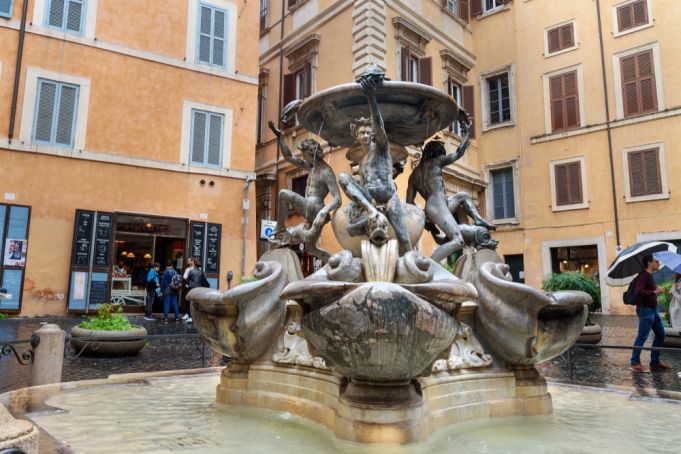
(ph: Elena Odareeva / Shutterstock.com)
This fountain is one of our favourites because of its gentle disposition, its legend and its location in a Roman neighbourhood with a heart-breaking history. Found in Piazza Mattei in the Jewish Quarter of the city, the story Turtle Fountain is that Duke Mattei, gambled away his home one night. The news reached his prospective father-in-law, who then refused to give his daughter to this gambler who had lost everything.
The duke promised to build a fountain in front of his house in just one night, in return for the marriage to go ahead. By morning, it was achieved. But the Duke’s trick was that the fountain had already been built years earlier and he simply arranged for it to be moved in front of his palace.
But more interesting than the story is the loveliness of this diminutive fountain, which features bronze turtles leaping from the top of the fountain, held aloft by bronze youths.Giacomo della Porta’s original in the 1580s featured dolphins, but these were replaced with little turtles by Bernini nearly 100 years later.
These curious little animals have been the subject of numerous thefts over the years, so much so that in 1979 they were removed and replaced with copies (the original sculptures are kept in the Capitoline Museums).
During the late Renaissance, this fountain had more than decorative qualities – providing water for the whole neighbourhood, which is where all Jewish families in the 1500s were forced to live in the area around Teatro Marcello, creating the Jewish Ghetto.
Tip for foodies: While you're in the area, don't miss a walk in the Ghetto to taste the dishes of Roman Jewish tradition. The carciofi alla giudia are a must!
Editorial credit: vvoe / Shutterstock.com




















